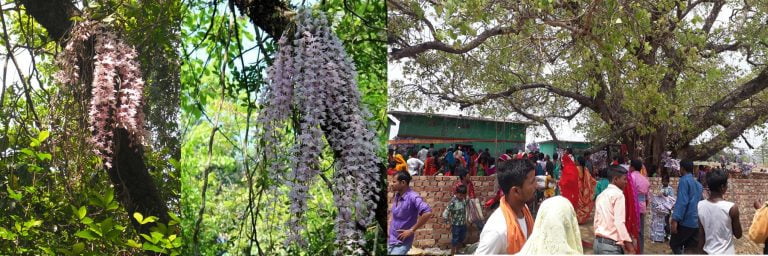
There is hardly anyone who is not attracted to flowers. Salahesh Fulbari is a religious and historical site in Siswani Village Development Committee of Siraha District. This garden is located 3km west-south of Lahan in Siraha. Spread over about 12 bighas, this garden is famous as the fulbari of Dusadh and Salahesh, the best deity of Danuwar caste.
There are millions of trees in this garden. However, the speciality of this garden is, among all the trees, one tree blooms only in the New Year. In the middle of the Salahesh Fulbari, on the branch of a tree called Haram, a garland-shaped white flower blooms for one day, every morning, on the first day of the new year. Surprisingly, the flowers wither in the evening.
This enchanting natural feature of Siraha attracts millions of Nepalis and Indians every year. This miracle of flowers blooming only on the first day of the new year is celebrated as Salahesh Phulbari Mela. As soon as the New Year comes, the minds of the people of Mithila get stuck in the flower garden. The Malin temple, in the centre of the fulbari, is associated with the garland-shaped flower that blooms in the centre of the Haram tree, which is located at the south.
History
The story is related to the relationship between the 14th century king Salahesh and his girlfriend Malini Reshma, Kushma and Dauna. At that time, the headquarters of Siraha was called Mysothagad and its king was Salahesh.
King Salahesh used to bathe in Malini Daha, pick flowers in Phulbari, play wrestling in Siltah Khand, and perform puja and worship at Salahesh Gad. It is believed that a garland shaped Malini appeared each year on new year for King Salahesh and his girlfriend.
Salhesh Fulbari Mela (New Year)
Since Reshma, Kushma and Dauna’s dream of marrying Salahesh didn’t fulfill, millions of devotees from India and Nepal flock to Nepal every year on the 1st of Baishakh to remember their love. So, in memory of the 14th century King Salahesh, a fair is organized on the 1st of Baishakh to commemorate the legends associated with Salahesh’s bravery, beauty, courage, heroism, and love. This fair is known as Salahesh Fulbari Mela. People flock to see the golden flower (Sunakhari) and silver flower (Chadigava) that bloom only on this day every year.
In the flower garden of 12 bigha, water flows from the roots all around. After entering the flower garden, the feeling of peace and love arises by itself and not only the people of the region, but also the people of Patna, Vihar, Vangal and Delhi in India have been attracted by the desire of those who take vows. Thirty percent of the devotees who come to visit this fulbari are Indian spectators.
Importance of Salahesh Fulbari
Another name for Sungava flower, found in fulbari, is Dendavium phylum. The book published by the Department of Botany in 2016, after studying this flower, discusses every plant of Salahesh Phulbari. There have been various beliefs towards this flower.
Shamans say that after taking the cool water of Salahesh Fulbari from different flowers such as Haram Pakair, Lava Sohra and other various herbs, any anger subsides. In this region, water from the Salahesh flower garden is used to fill the urn during religious ceremonies and even after the cholera epidemic. So, the water of Salahesh Fulbari is considered as medicine and cured.
Salahesh Temple
There is a Malini temple with an idol near the Haram tree. There is also a Salahesh temple at 50 meters from it. There is a faith that the wishes made there will be fulfilled. The youngsters keep the flower as a witness and tie it in the love thread. There is a magnificent statue of Salahesh and Malini inside the traditional cave. According to the priest, the dug wells and the Baliganga river flow behind the temple and the dug wells are only visible sometimes.
There is also a tradition of sacrificing goats after fulfilling the vows. Devotees who come to see the fair worship Salahesh and vow to have children, good health, and a successful life.
Final Thoughts
The historical places associated with the saga of Salahesh have a deep connection with the life of the people of Siraha district. It is believed that excavating the remains of archaeological significance of this fulbari will help in attracting internal and external tourists. Since this fulbari has been listed on the list of 100 new tourist destinations in Nepal, it is our duty to promote and preserve the historical value carried by this garden.
-Article written by: Kusum Kharel for Land Nepal